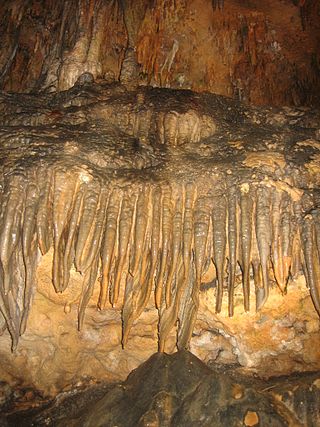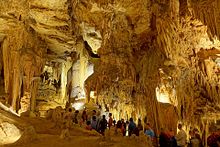Luray Caverns
| Luray Caverns
|
||
|---|---|---|
|
The Fishmarket , so named because the stalactites are reminiscent of fish hanging out to dry. |
||
| Location: | Virginia, USA | |
| Height : | 282 m | |
|
Geographic location: |
38 ° 39 '51.8 " N , 78 ° 28' 54.4" W | |
|
|
||
| Discovery: | August 13, 1878 | |
| Show cave since: | Yes | |
| Length of the show cave area: |
approx. 1.5 km | |
| Particularities: | "Great Stalacpipe Organ", an organ made of stalactites | |
| Website: | http://www.luraycaverns.com | |
The Luray Caverns are the largest cave system in the eastern United States with around 26 hectares . The cave, which has been designated a National Natural Landmark since 1974, with its colorful rooms is located just outside the city of Luray in the immediate vicinity of Shenandoah National Park and the Blue Ridge Mountains in northwest Virginia .
history
The cave was discovered on August 13, 1878 by the blacksmith Andrew Campbell, his nephew William Campbell and the local photographer Benton Stebbins. At first they noticed a cool draft from the ground and started digging at the place. About five hours later, Andrew Campbell was the first to descend into the cave system.
At that point, the land on which the caves were discovered belonged to Sam Buracker. However, his land was auctioned on September 14, 1878 because of unpaid debts. Andrew Campbell, William Campbell and Benton Stebbins, who knew about the auction, bought the area and only revealed their discovery after the purchase. Since the real value of the land was not known at the time of purchase, two years of legal proceedings followed. In 1881 the purchase was canceled by the Virginia Supreme Court. The land was then sold to the Luray Cave and Hotel Company , a subsidiary of the Shenandoah Railroad Company .
In 1901, TC Northcott, the former president of the Luray Caverns Corporation, built the "Limair" sanatorium on the top of the cave hill. The very clean and germ-free cave air was fed into the building with a fan and could be exchanged every four minutes. After the original building fell victim to a fire, the sanatorium was rebuilt as a brick building.
Emergence
The cave emerged with the end of the Tertiary , when the Shenandoah Valley also emerged. Acidic water that ran off eroded away the softer rock layers. Stalactites and stalagmites began to form. Some of these have grown together and form the so-called stalagnates ( columns ), which are up to 16 m high. Since carbonated water continues to penetrate the rock, the process is not yet complete.
Great Stalacpipe Organ
The Great Stalacpipe Organ is the largest underground musical instrument in the world according to the Guinness Book . Rubber-coated hammers are attached to selected stalactites on an area of more than 14,000 m², which make the stone vibrate and thus produce sounds. The instrument was developed and built in 1954 by Leland W. Sprinkle, a mathematician and electronics engineer at the Pentagon .
Despite the rubber covers, stalactites occasionally break off while playing. Then the corresponding note is missing in the organ repertoire until an employee moves the hammer to another suitable stalactite, which is cut to the correct length by sawing it off and thus tuned. Obviously the Great Stalacpipe Organ is not an instrument for eternity.
The Great Stalacpipe Organ can be heard on Pepe Deluxé's fourth album , Queen of the Wave .
Show cave
The caves can be visited in a guided tour. The approximately one-hour tours cost between US $ 14 and US $ 27, and the price includes a visit to the Historic Car & Carriage Caravan Museum (as of October 2017). The Great Stalcpipe Organ is also played by a computerized system during the tour.
The Luray Caverns count around 500,000 visitors annually.
It is also unusual that the cave air is chemically dried. This eliminates the cold effect due to high humidity. Although this is very pleasant for the visitors, it dries out the stalactite formation and prevents the natural further development of the cave world.



